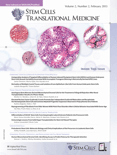
Stem Cells Translational Medicine
Scope & Guideline
Transforming Discoveries into Clinical Applications
Introduction
Aims and Scopes
- Stem Cell Therapy Applications:
The journal emphasizes the clinical applications of various stem cell types, including mesenchymal stem cells (MSCs), induced pluripotent stem cells (iPSCs), and their derivatives for treating a wide array of diseases, particularly in regenerative medicine. - Mechanisms of Stem Cell Function:
Research on the biological mechanisms underlying stem cell differentiation, proliferation, and functionality, including studies on signaling pathways, cellular interactions, and the effects of the microenvironment. - Development of Novel Therapeutics:
Focus on the development and evaluation of new therapeutic strategies utilizing stem cells, including engineered cell products and cell-derived extracellular vesicles, to enhance treatment efficacy. - Regulatory and Ethical Considerations:
Exploration of regulatory frameworks, ethical implications, and standardization in the use of stem cells and their derivatives in clinical settings. - Translational Research Methodologies:
Utilization of innovative research methodologies and technologies, such as 3D bioprinting, bioengineering, and high-throughput screening, to facilitate the translation of stem cell research into clinical practice.
Trending and Emerging
- Extracellular Vesicles and Secretomes:
There is an increasing focus on the therapeutic potential of extracellular vesicles derived from stem cells, particularly in their ability to mediate paracrine effects and provide a cell-free alternative for regenerative therapies. - Personalized Medicine Approaches:
Research is trending towards personalized medicine, where stem cell therapies are tailored to individual patient profiles, leveraging iPSCs derived from patients for disease modeling and customized treatment strategies. - 3D Bioprinting and Tissue Engineering:
Innovative methodologies such as 3D bioprinting are emerging as key areas, enabling the creation of complex tissue constructs that can better mimic natural tissue architecture for regenerative applications. - Immunomodulation and Inflammation Control:
Increasing attention is being paid to the immunomodulatory properties of stem cells, particularly MSCs, in managing inflammation and enhancing tissue repair, highlighting their dual role as both therapeutic agents and modulators of the immune response. - Regenerative Strategies for Specific Diseases:
Focused research on specific diseases, such as neurodegenerative disorders and chronic inflammatory conditions, is trending, showcasing targeted approaches for using stem cells in precision medicine.
Declining or Waning
- Basic Stem Cell Biology Studies:
There has been a noticeable decline in publications strictly focused on fundamental stem cell biology without direct translational implications, as the field shifts towards more applied research. - Non-Cell-Based Therapeutics:
Research focusing on non-cell-based therapeutic interventions, such as small molecules or traditional drug therapies, is becoming less prominent in the context of the journal's focus on cell-based therapies. - Animal Models in Preclinical Studies:
There is a diminishing trend in studies that predominantly rely on animal models for testing stem cell therapies, as researchers increasingly seek alternative models that better mimic human physiology. - Single Therapeutic Approaches:
The trend is moving away from studies advocating single therapeutic approaches, with more research emphasizing combinatorial therapies that integrate multiple modalities for enhanced efficacy.
Similar Journals
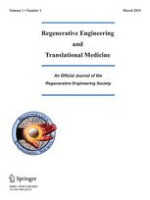
Regenerative Engineering and Translational Medicine
Advancing the Future of Regenerative MedicineRegenerative Engineering and Translational Medicine is an esteemed academic journal published by Springer Heidelberg, focusing on the interdisciplinary fields of biomaterials, biomedical engineering, and cell biology. With an ISSN of 2364-4133 and an E-ISSN of 2364-4141, the journal has carved a niche for itself since its inception in 2015, showcasing cutting-edge research that bridges the gap between scientific findings and practical applications in regenerative medicine. As a recognized platform in its field, it is currently positioned within Q3 quartiles in biomaterials, biomedical engineering, and medicine (miscellaneous), with a Scopus ranking that reflects its growing influence among peers. The journal aims to disseminate high-quality, peer-reviewed articles that highlight advancements in regenerative engineering, further advancing both theoretical and applied research. Scholars and practitioners seeking to stay at the forefront of the ever-evolving landscape of regenerative health solutions will find invaluable insights and innovations within these pages. Join a community of leading thinkers and explore the journal's comprehensive research contributions, which are crucial for fostering partnerships between academia and industry in the quest for transformative medical solutions.

IN VITRO CELLULAR & DEVELOPMENTAL BIOLOGY-ANIMAL
Transforming Knowledge in Cell BiologyIN VITRO CELLULAR & DEVELOPMENTAL BIOLOGY-ANIMAL, published by SPRINGER, is a pivotal journal in the fields of cell biology and developmental biology, focusing on in vitro studies that enhance our understanding of animal cellular mechanisms and development. With an ISSN of 1071-2690 and an E-ISSN of 1543-706X, this esteemed journal offers a platform for researchers to present their findings and contribute to the body of knowledge necessary for advancements in biological sciences. As a recognized publication, it holds a 2023 category quartile of Q4 in Cell Biology and Developmental Biology, and Q3 in miscellaneous Medicine, reflecting its competitive position yet inviting critical submissions that can span multidisciplinary approaches. Though currently not open access, it serves as an essential resource for professionals, researchers, and students dedicated to unraveling the complexities of cellular processes in an ever-evolving field. The journal has been continuously published since 1986, signifying its long-standing commitment to fostering scientific discourse and innovation.

BIOCELL
Fostering Excellence in Cell ResearchBIOCELL is a distinguished peer-reviewed journal dedicated to the field of Cell Biology, published by TECH SCIENCE PRESS. Since its inception in 1995, the journal has been at the forefront of disseminating innovative research, with converged publication years extending from 1995 to 2013 and from 2015 to 2024. Although it currently holds a Q4 ranking in the Cell Biology category according to the 2023 category quartiles, BIOCELL aims to foster advancements by providing a platform for researchers, professionals, and students to share their findings in biochemistry, genetics, and molecular biology. The journal is available in both print (ISSN: 0327-9545) and digital formats (E-ISSN: 1667-5746) and seeks to attract contributions that enhance scholarly dialogue and understandings of cellular mechanisms and innovations. With a commitment to quality research and critical discourse, BIOCELL plays an important role in nurturing the scientific community within Argentina and beyond, offering vital insights that contribute to the advancement of the life sciences.
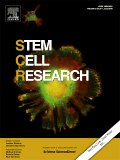
Stem Cell Research
Leading the conversation on ethical stem cell applications.Stem Cell Research is a premier Open Access journal published by ELSEVIER, dedicated to advancing the understanding of stem cell biology. Since its inception in 2007, the journal has provided a platform for the latest research in the fields of Cell Biology, Developmental Biology, and Medicine, with its publication being accessible globally since 2014. Located in the Netherlands, the journal’s comprehensive scope aims to bridge fundamental discoveries with clinical applications, fostering collaboration among researchers and professionals. With a 2023 impact factor reflected in its Q4 ranking in Cell and Developmental Biology and a commendable position in the 64th percentile for General Medicine, Stem Cell Research remains a vital resource for those interested in the dynamic landscape of regenerative medicine. Targeting an audience that includes researchers, practitioners, and students, the journal emphasizes not only the significance of stem cells in medical science but also the ethical considerations and the public discourse surrounding stem cell research. Join the community committed to pioneering the future of stem cell science through rigorous peer-reviewed research.

American Journal of Stem Cells
Transforming stem cell research into real-world applications.American Journal of Stem Cells is a leading multidisciplinary publication dedicated to advancing the field of regenerative medicine and stem cell research. Published by E-CENTURY PUBLISHING CORP, this journal has gained recognition for its commitment to high-quality scientific contributions, achieving impressive rankings within the Scopus database, particularly in the areas of Biochemistry, Genetics and Molecular Biology, and Developmental Biology. With its focus on innovative research, the journal offers crucial insights and developments that appeal to researchers, professionals, and students alike. Although it is not an open-access journal, the American Journal of Stem Cells plays a pivotal role in disseminating impactful findings that define the future of cellular therapies and regenerative methodologies. The journal's past coverage from 2012 to 2017 reflects its dedication to advancing knowledge in key scientific disciplines, making it an essential resource for anyone engaged in the dynamic landscape of stem cell science.

Stem Cell Research & Therapy
Catalyzing Discoveries in Molecular MedicineStem Cell Research & Therapy is an esteemed international journal published by BMC, specializing in the rapidly advancing fields of stem cell research and regenerative therapies. Since its inception in 2010, the journal has embraced an Open Access model, ensuring that vital research is readily accessible to a global audience. With a significant impact in the scientific community, it holds Q1 quartile rankings in prestigious categories such as Biochemistry, Genetics and Molecular Biology, Cell Biology, and Molecular Medicine, highlighting its critical role in promoting groundbreaking research. The journal’s high Scopus rankings—placing it in the top echelons of its fields—reflect its commitment to publishing high-quality, peer-reviewed studies that advance our understanding of stem cell biology and therapeutic applications. Aimed at researchers, healthcare professionals, and students alike, Stem Cell Research & Therapy is an indispensable resource for those dedicated to the exploration and innovation within this transformative area of science.
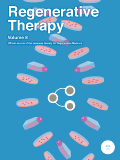
Regenerative Therapy
Advancing regenerative medicine through open access innovation.Regenerative Therapy is a premier open-access journal dedicated to advancing the fields of biomaterials, biomedical engineering, and developmental biology. Published by Elsevier in Japan, this journal has been an influential platform since its inception in 2015, contributing significantly to the global discourse on regenerative medicine. With an impressive Q2 ranking in major categories such as Biomaterials and Biomedical Engineering, it is recognized for its quality of research and innovation. Researchers seeking to disseminate their findings or explore cutting-edge developments will find Regenerative Therapy to be invaluable, reflecting current trends and fostering collaborations across interdisciplinary boundaries. The journal offers open access, ensuring that high-quality research is available to a broad audience and enhances the impact of scholarly work in the regenerative medicine community.
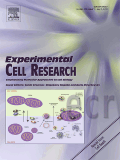
EXPERIMENTAL CELL RESEARCH
Exploring the Frontiers of Cell BiologyEXPERIMENTAL CELL RESEARCH is a highly respected journal published by Elsevier Inc, specializing in the dynamic and ever-evolving field of Cell Biology. With an impact factor positioned in the Q2 quartile for 2023, it ranks at the 124th position out of 285 in the Scopus Ranks, indicating a solid reputation among peers in the domains of biochemistry, genetics, and molecular biology. Since its inception in 1950, the journal has contributed significantly to the dissemination of groundbreaking research, providing a platform for studies that explore the nuances of cellular mechanisms, processes, and experimental methodologies. Although the journal currently does not offer open access, its commitment to high-quality, peer-reviewed research continues to attract submissions from leading scientists and scholars across the globe. Researchers, professionals, and students alike will find this journal an invaluable resource for keeping abreast of current developments and innovative breakthroughs in cellular science.
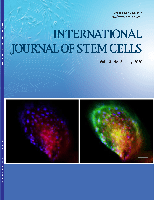
International Journal of Stem Cells
Elevating the Dialogue in Stem Cell ScienceThe International Journal of Stem Cells is a distinguished peer-reviewed journal dedicated to advancing the field of stem cell research. Published by the Korean Society for Stem Cell Research, this journal has established itself as a vital source of high-quality research since its inception in 2008. Operating under the ISSN 2005-3606 and E-ISSN 2005-5447, the journal caters to a global audience, featuring works that span a diverse array of topics within Cell Biology and Developmental Biology. It is noteworthy that as of 2023, the journal is ranked Q3 in Cell Biology and Q2 in Developmental Biology, highlighting its growing influence and credibility in the scientific community. Given its commitment to facilitating open scientific communication, it is crucial for researchers, professionals, and students to engage with the rigorous research published in this journal as it profoundly impacts the understanding and application of stem cell science. With accessibility to a wealth of innovative studies, the International Journal of Stem Cells remains an indispensable resource for anyone interested in the transformative potential of stem cell research.
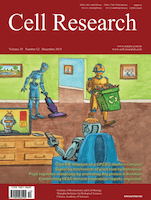
CELL RESEARCH
Advancing the Frontiers of Cell BiologyCELL RESEARCH is a premier peer-reviewed journal dedicated to advancing the field of cell biology and molecular biology, published by SpringerNature. With an impressive impact factor and consistently ranking in the Q1 quartile for both cell biology and molecular biology, this journal serves as a pivotal resource for researchers, professionals, and students seeking to explore the latest discoveries and advancements in cellular mechanisms and their implications for health and disease. Since its inception in 1996, CELL RESEARCH has cultivated a distinguished reputation, currently boasting ranks in the top percentile of Scopus categories, reaffirming its influence and relevance to the scientific community. Although it is not an Open Access journal, its rigorous selection process ensures the publication of high-quality articles that contribute significantly to our understanding of life sciences. For those deeply engaged in the realms of biochemistry, genetics, and molecular biology, CELL RESEARCH is an essential conduit of innovative research and critical insights.